Evaluating Sustainable Tourism Development in Qatar
VerifiedAdded on 2024/06/05
|37
|5923
|208
Report
AI Summary
This report provides a comprehensive analysis of sustainable tourism development in Qatar, examining various facets such as stakeholder benefits, planning approaches, and impact measurement. It delves into the advantages and disadvantages of public/private sector partnerships in tourism planning, highlighting examples specific to Qatar. The report analyzes tourism development planning at different levels (sub-regional, regional, and national) and evaluates the significance of interactive planning systems. Furthermore, it assesses methods for measuring tourist impact, addresses conflict resolution in developing destinations, analyzes the balance between supply and demand, and evaluates the ethical issues of enclave tourism in Qatar. The report also compares tourism development issues in developing and emerging destinations and offers recommendations for the future development of tourism, emphasizing sustainability and responsible practices. This document is available on Desklib, where students can access a wealth of study resources, including past papers and solved assignments.

SUSTAINABLE TOURISM DEVELOPMENT
Paraphrase This Document
Need a fresh take? Get an instant paraphrase of this document with our AI Paraphraser
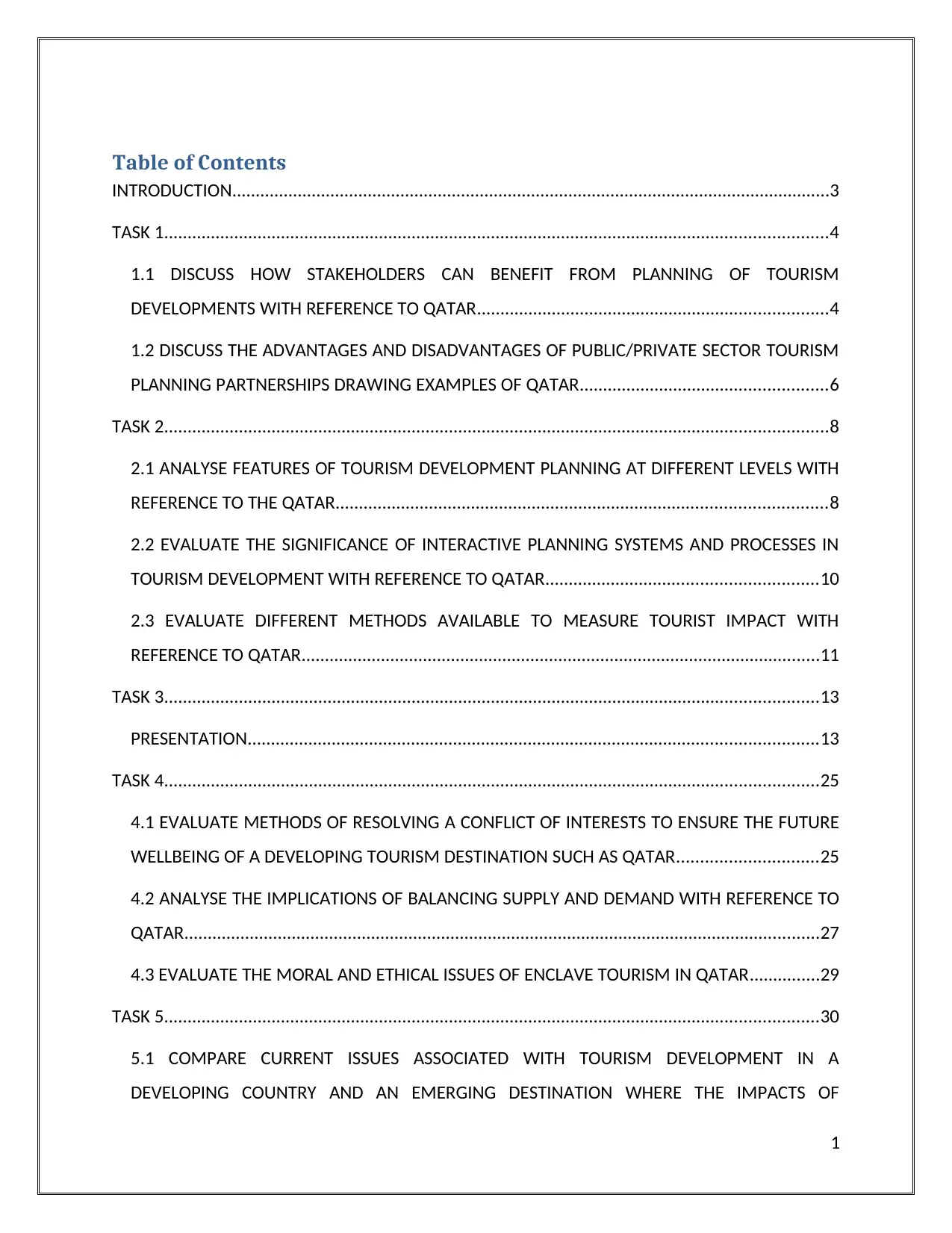
Table of Contents
INTRODUCTION................................................................................................................................3
TASK 1..............................................................................................................................................4
1.1 DISCUSS HOW STAKEHOLDERS CAN BENEFIT FROM PLANNING OF TOURISM
DEVELOPMENTS WITH REFERENCE TO QATAR...........................................................................4
1.2 DISCUSS THE ADVANTAGES AND DISADVANTAGES OF PUBLIC/PRIVATE SECTOR TOURISM
PLANNING PARTNERSHIPS DRAWING EXAMPLES OF QATAR.....................................................6
TASK 2..............................................................................................................................................8
2.1 ANALYSE FEATURES OF TOURISM DEVELOPMENT PLANNING AT DIFFERENT LEVELS WITH
REFERENCE TO THE QATAR.........................................................................................................8
2.2 EVALUATE THE SIGNIFICANCE OF INTERACTIVE PLANNING SYSTEMS AND PROCESSES IN
TOURISM DEVELOPMENT WITH REFERENCE TO QATAR..........................................................10
2.3 EVALUATE DIFFERENT METHODS AVAILABLE TO MEASURE TOURIST IMPACT WITH
REFERENCE TO QATAR...............................................................................................................11
TASK 3............................................................................................................................................13
PRESENTATION..........................................................................................................................13
TASK 4............................................................................................................................................25
4.1 EVALUATE METHODS OF RESOLVING A CONFLICT OF INTERESTS TO ENSURE THE FUTURE
WELLBEING OF A DEVELOPING TOURISM DESTINATION SUCH AS QATAR..............................25
4.2 ANALYSE THE IMPLICATIONS OF BALANCING SUPPLY AND DEMAND WITH REFERENCE TO
QATAR........................................................................................................................................27
4.3 EVALUATE THE MORAL AND ETHICAL ISSUES OF ENCLAVE TOURISM IN QATAR...............29
TASK 5............................................................................................................................................30
5.1 COMPARE CURRENT ISSUES ASSOCIATED WITH TOURISM DEVELOPMENT IN A
DEVELOPING COUNTRY AND AN EMERGING DESTINATION WHERE THE IMPACTS OF
1
INTRODUCTION................................................................................................................................3
TASK 1..............................................................................................................................................4
1.1 DISCUSS HOW STAKEHOLDERS CAN BENEFIT FROM PLANNING OF TOURISM
DEVELOPMENTS WITH REFERENCE TO QATAR...........................................................................4
1.2 DISCUSS THE ADVANTAGES AND DISADVANTAGES OF PUBLIC/PRIVATE SECTOR TOURISM
PLANNING PARTNERSHIPS DRAWING EXAMPLES OF QATAR.....................................................6
TASK 2..............................................................................................................................................8
2.1 ANALYSE FEATURES OF TOURISM DEVELOPMENT PLANNING AT DIFFERENT LEVELS WITH
REFERENCE TO THE QATAR.........................................................................................................8
2.2 EVALUATE THE SIGNIFICANCE OF INTERACTIVE PLANNING SYSTEMS AND PROCESSES IN
TOURISM DEVELOPMENT WITH REFERENCE TO QATAR..........................................................10
2.3 EVALUATE DIFFERENT METHODS AVAILABLE TO MEASURE TOURIST IMPACT WITH
REFERENCE TO QATAR...............................................................................................................11
TASK 3............................................................................................................................................13
PRESENTATION..........................................................................................................................13
TASK 4............................................................................................................................................25
4.1 EVALUATE METHODS OF RESOLVING A CONFLICT OF INTERESTS TO ENSURE THE FUTURE
WELLBEING OF A DEVELOPING TOURISM DESTINATION SUCH AS QATAR..............................25
4.2 ANALYSE THE IMPLICATIONS OF BALANCING SUPPLY AND DEMAND WITH REFERENCE TO
QATAR........................................................................................................................................27
4.3 EVALUATE THE MORAL AND ETHICAL ISSUES OF ENCLAVE TOURISM IN QATAR...............29
TASK 5............................................................................................................................................30
5.1 COMPARE CURRENT ISSUES ASSOCIATED WITH TOURISM DEVELOPMENT IN A
DEVELOPING COUNTRY AND AN EMERGING DESTINATION WHERE THE IMPACTS OF
1
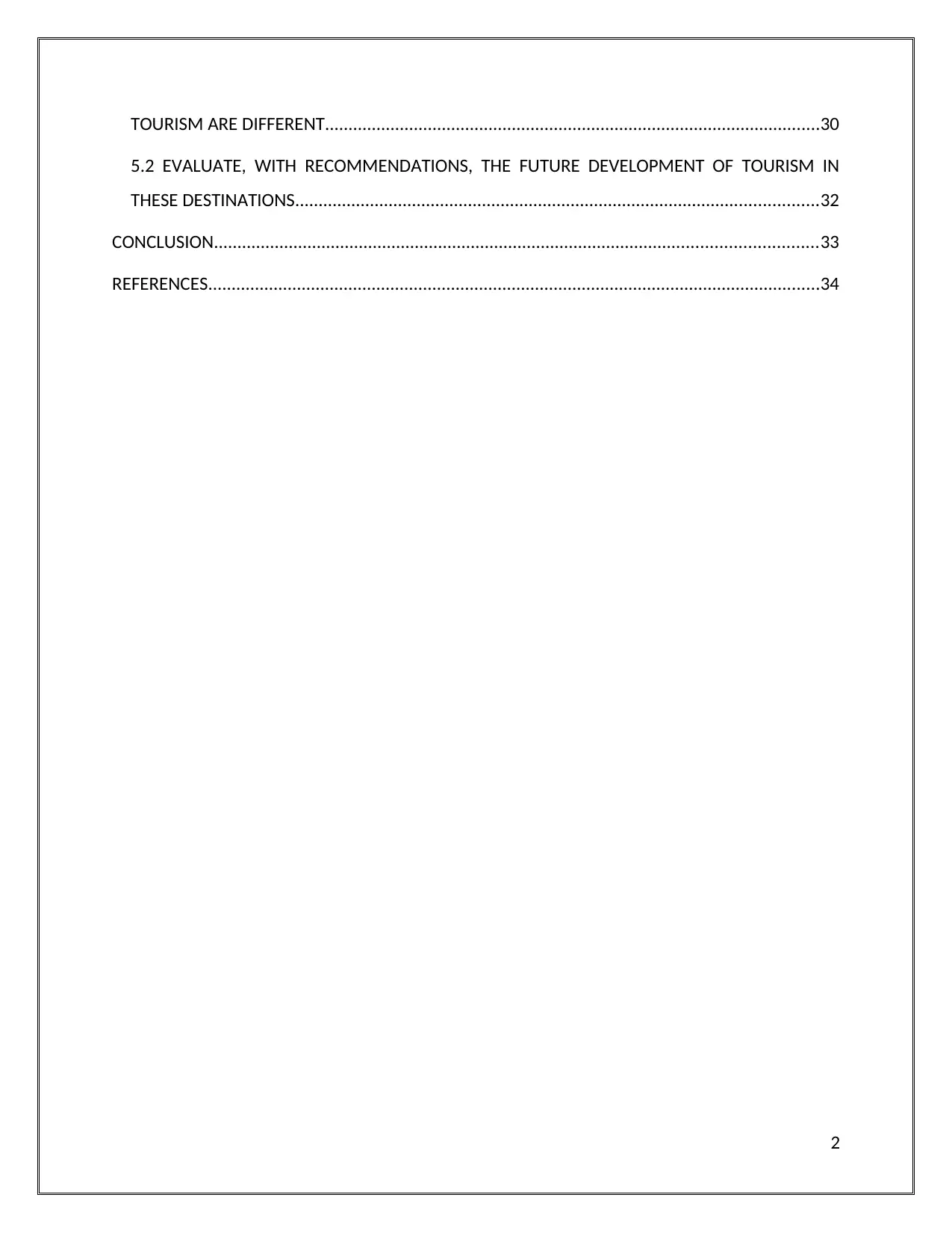
TOURISM ARE DIFFERENT..........................................................................................................30
5.2 EVALUATE, WITH RECOMMENDATIONS, THE FUTURE DEVELOPMENT OF TOURISM IN
THESE DESTINATIONS................................................................................................................32
CONCLUSION.................................................................................................................................33
REFERENCES...................................................................................................................................34
2
5.2 EVALUATE, WITH RECOMMENDATIONS, THE FUTURE DEVELOPMENT OF TOURISM IN
THESE DESTINATIONS................................................................................................................32
CONCLUSION.................................................................................................................................33
REFERENCES...................................................................................................................................34
2
⊘ This is a preview!⊘
Do you want full access?
Subscribe today to unlock all pages.

Trusted by 1+ million students worldwide
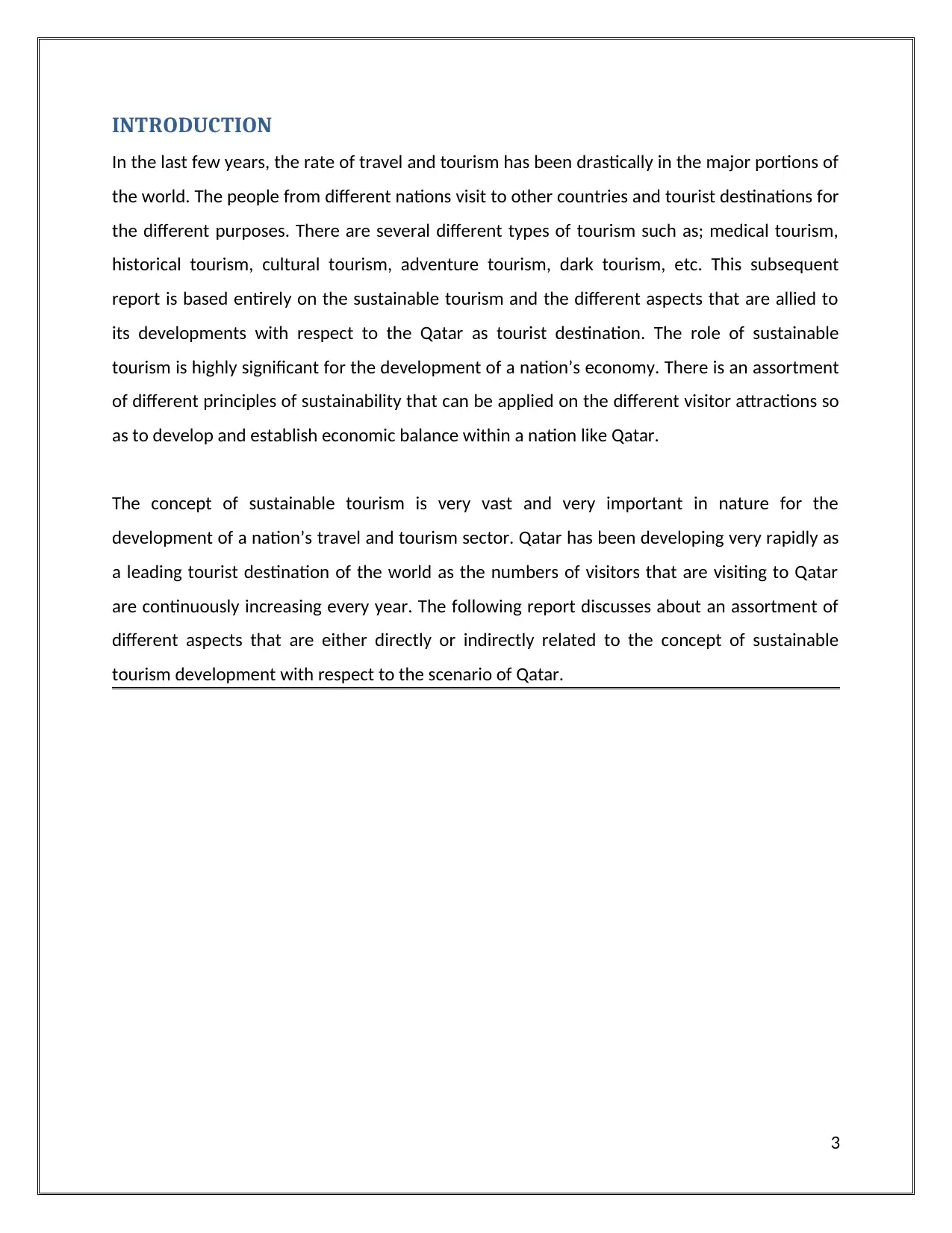
INTRODUCTION
In the last few years, the rate of travel and tourism has been drastically in the major portions of
the world. The people from different nations visit to other countries and tourist destinations for
the different purposes. There are several different types of tourism such as; medical tourism,
historical tourism, cultural tourism, adventure tourism, dark tourism, etc. This subsequent
report is based entirely on the sustainable tourism and the different aspects that are allied to
its developments with respect to the Qatar as tourist destination. The role of sustainable
tourism is highly significant for the development of a nation’s economy. There is an assortment
of different principles of sustainability that can be applied on the different visitor attractions so
as to develop and establish economic balance within a nation like Qatar.
The concept of sustainable tourism is very vast and very important in nature for the
development of a nation’s travel and tourism sector. Qatar has been developing very rapidly as
a leading tourist destination of the world as the numbers of visitors that are visiting to Qatar
are continuously increasing every year. The following report discusses about an assortment of
different aspects that are either directly or indirectly related to the concept of sustainable
tourism development with respect to the scenario of Qatar.
3
In the last few years, the rate of travel and tourism has been drastically in the major portions of
the world. The people from different nations visit to other countries and tourist destinations for
the different purposes. There are several different types of tourism such as; medical tourism,
historical tourism, cultural tourism, adventure tourism, dark tourism, etc. This subsequent
report is based entirely on the sustainable tourism and the different aspects that are allied to
its developments with respect to the Qatar as tourist destination. The role of sustainable
tourism is highly significant for the development of a nation’s economy. There is an assortment
of different principles of sustainability that can be applied on the different visitor attractions so
as to develop and establish economic balance within a nation like Qatar.
The concept of sustainable tourism is very vast and very important in nature for the
development of a nation’s travel and tourism sector. Qatar has been developing very rapidly as
a leading tourist destination of the world as the numbers of visitors that are visiting to Qatar
are continuously increasing every year. The following report discusses about an assortment of
different aspects that are either directly or indirectly related to the concept of sustainable
tourism development with respect to the scenario of Qatar.
3
Paraphrase This Document
Need a fresh take? Get an instant paraphrase of this document with our AI Paraphraser
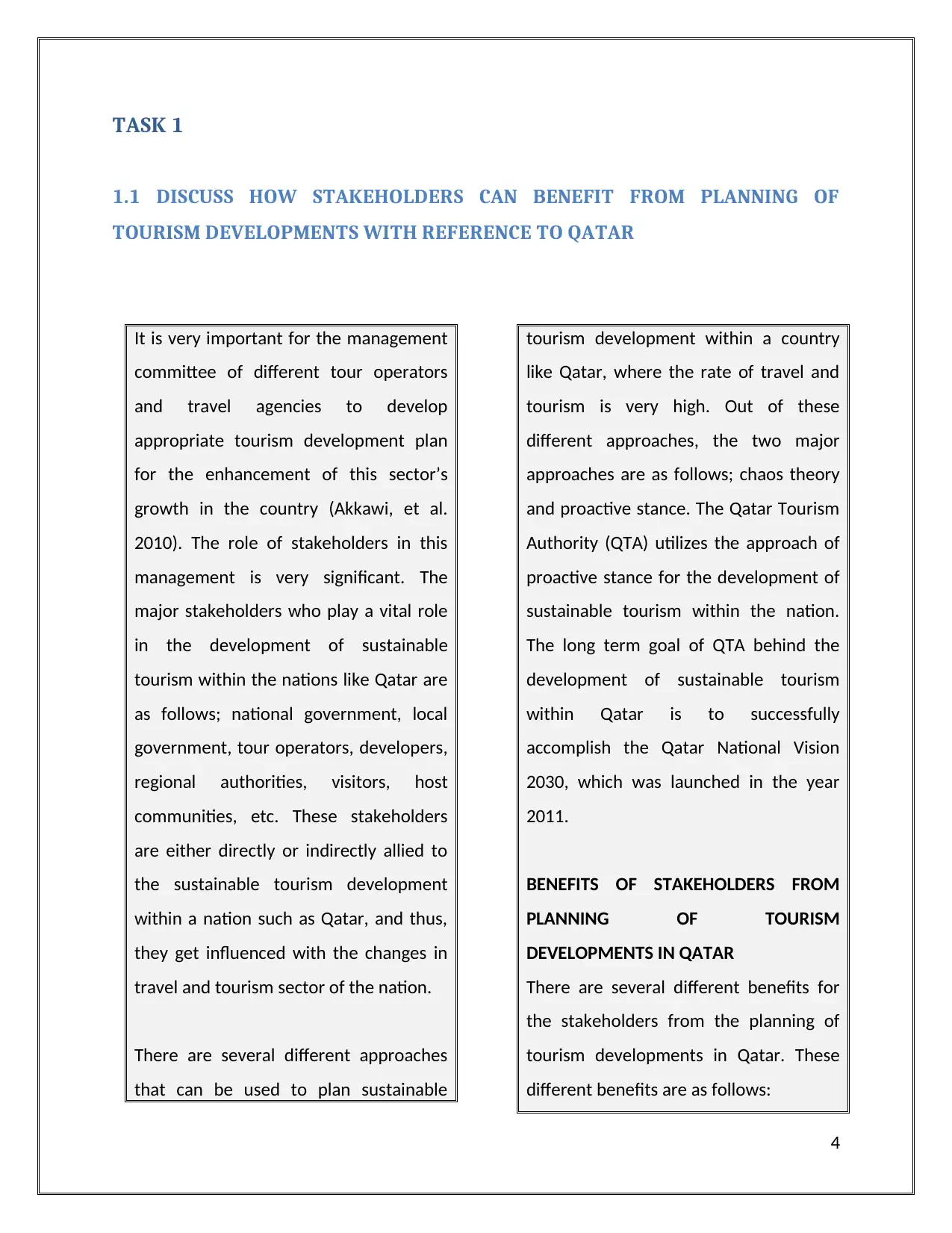
TASK 1
1.1 DISCUSS HOW STAKEHOLDERS CAN BENEFIT FROM PLANNING OF
TOURISM DEVELOPMENTS WITH REFERENCE TO QATAR
It is very important for the management
committee of different tour operators
and travel agencies to develop
appropriate tourism development plan
for the enhancement of this sector’s
growth in the country (Akkawi, et al.
2010). The role of stakeholders in this
management is very significant. The
major stakeholders who play a vital role
in the development of sustainable
tourism within the nations like Qatar are
as follows; national government, local
government, tour operators, developers,
regional authorities, visitors, host
communities, etc. These stakeholders
are either directly or indirectly allied to
the sustainable tourism development
within a nation such as Qatar, and thus,
they get influenced with the changes in
travel and tourism sector of the nation.
There are several different approaches
that can be used to plan sustainable
tourism development within a country
like Qatar, where the rate of travel and
tourism is very high. Out of these
different approaches, the two major
approaches are as follows; chaos theory
and proactive stance. The Qatar Tourism
Authority (QTA) utilizes the approach of
proactive stance for the development of
sustainable tourism within the nation.
The long term goal of QTA behind the
development of sustainable tourism
within Qatar is to successfully
accomplish the Qatar National Vision
2030, which was launched in the year
2011.
BENEFITS OF STAKEHOLDERS FROM
PLANNING OF TOURISM
DEVELOPMENTS IN QATAR
There are several different benefits for
the stakeholders from the planning of
tourism developments in Qatar. These
different benefits are as follows:
4
1.1 DISCUSS HOW STAKEHOLDERS CAN BENEFIT FROM PLANNING OF
TOURISM DEVELOPMENTS WITH REFERENCE TO QATAR
It is very important for the management
committee of different tour operators
and travel agencies to develop
appropriate tourism development plan
for the enhancement of this sector’s
growth in the country (Akkawi, et al.
2010). The role of stakeholders in this
management is very significant. The
major stakeholders who play a vital role
in the development of sustainable
tourism within the nations like Qatar are
as follows; national government, local
government, tour operators, developers,
regional authorities, visitors, host
communities, etc. These stakeholders
are either directly or indirectly allied to
the sustainable tourism development
within a nation such as Qatar, and thus,
they get influenced with the changes in
travel and tourism sector of the nation.
There are several different approaches
that can be used to plan sustainable
tourism development within a country
like Qatar, where the rate of travel and
tourism is very high. Out of these
different approaches, the two major
approaches are as follows; chaos theory
and proactive stance. The Qatar Tourism
Authority (QTA) utilizes the approach of
proactive stance for the development of
sustainable tourism within the nation.
The long term goal of QTA behind the
development of sustainable tourism
within Qatar is to successfully
accomplish the Qatar National Vision
2030, which was launched in the year
2011.
BENEFITS OF STAKEHOLDERS FROM
PLANNING OF TOURISM
DEVELOPMENTS IN QATAR
There are several different benefits for
the stakeholders from the planning of
tourism developments in Qatar. These
different benefits are as follows:
4
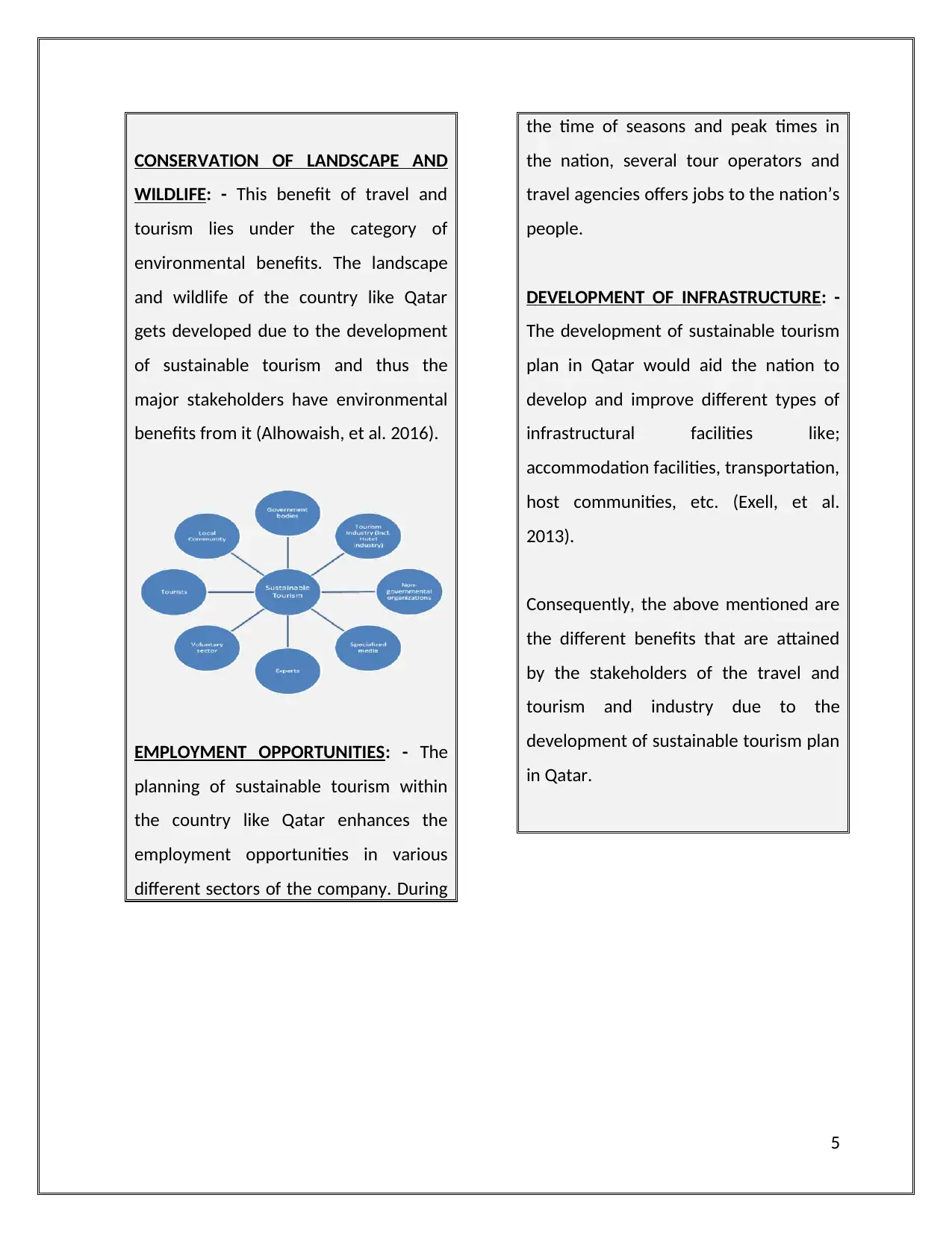
CONSERVATION OF LANDSCAPE AND
WILDLIFE: - This benefit of travel and
tourism lies under the category of
environmental benefits. The landscape
and wildlife of the country like Qatar
gets developed due to the development
of sustainable tourism and thus the
major stakeholders have environmental
benefits from it (Alhowaish, et al. 2016).
EMPLOYMENT OPPORTUNITIES: - The
planning of sustainable tourism within
the country like Qatar enhances the
employment opportunities in various
different sectors of the company. During
the time of seasons and peak times in
the nation, several tour operators and
travel agencies offers jobs to the nation’s
people.
DEVELOPMENT OF INFRASTRUCTURE: -
The development of sustainable tourism
plan in Qatar would aid the nation to
develop and improve different types of
infrastructural facilities like;
accommodation facilities, transportation,
host communities, etc. (Exell, et al.
2013).
Consequently, the above mentioned are
the different benefits that are attained
by the stakeholders of the travel and
tourism and industry due to the
development of sustainable tourism plan
in Qatar.
5
WILDLIFE: - This benefit of travel and
tourism lies under the category of
environmental benefits. The landscape
and wildlife of the country like Qatar
gets developed due to the development
of sustainable tourism and thus the
major stakeholders have environmental
benefits from it (Alhowaish, et al. 2016).
EMPLOYMENT OPPORTUNITIES: - The
planning of sustainable tourism within
the country like Qatar enhances the
employment opportunities in various
different sectors of the company. During
the time of seasons and peak times in
the nation, several tour operators and
travel agencies offers jobs to the nation’s
people.
DEVELOPMENT OF INFRASTRUCTURE: -
The development of sustainable tourism
plan in Qatar would aid the nation to
develop and improve different types of
infrastructural facilities like;
accommodation facilities, transportation,
host communities, etc. (Exell, et al.
2013).
Consequently, the above mentioned are
the different benefits that are attained
by the stakeholders of the travel and
tourism and industry due to the
development of sustainable tourism plan
in Qatar.
5
⊘ This is a preview!⊘
Do you want full access?
Subscribe today to unlock all pages.

Trusted by 1+ million students worldwide
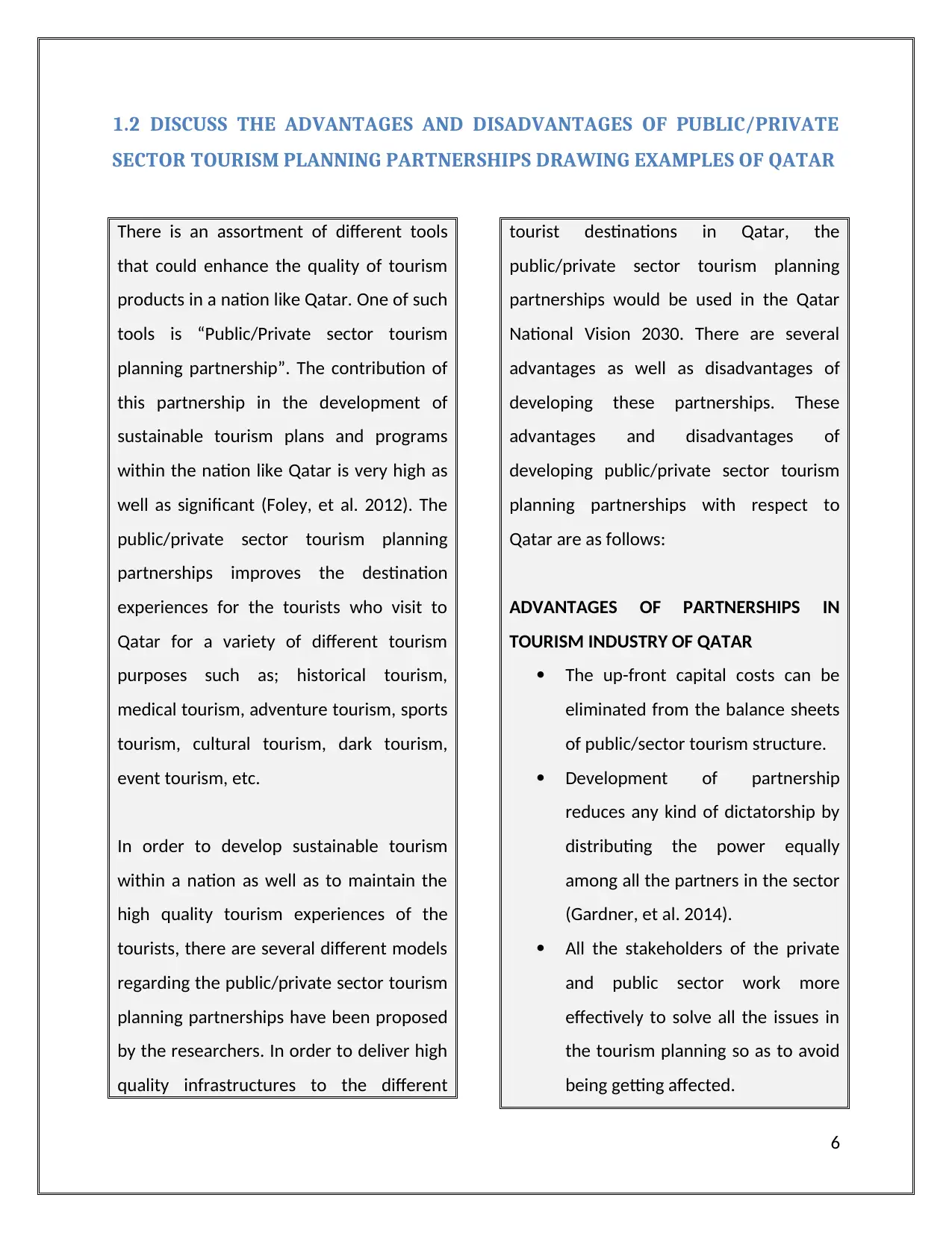
1.2 DISCUSS THE ADVANTAGES AND DISADVANTAGES OF PUBLIC/PRIVATE
SECTOR TOURISM PLANNING PARTNERSHIPS DRAWING EXAMPLES OF QATAR
There is an assortment of different tools
that could enhance the quality of tourism
products in a nation like Qatar. One of such
tools is “Public/Private sector tourism
planning partnership”. The contribution of
this partnership in the development of
sustainable tourism plans and programs
within the nation like Qatar is very high as
well as significant (Foley, et al. 2012). The
public/private sector tourism planning
partnerships improves the destination
experiences for the tourists who visit to
Qatar for a variety of different tourism
purposes such as; historical tourism,
medical tourism, adventure tourism, sports
tourism, cultural tourism, dark tourism,
event tourism, etc.
In order to develop sustainable tourism
within a nation as well as to maintain the
high quality tourism experiences of the
tourists, there are several different models
regarding the public/private sector tourism
planning partnerships have been proposed
by the researchers. In order to deliver high
quality infrastructures to the different
tourist destinations in Qatar, the
public/private sector tourism planning
partnerships would be used in the Qatar
National Vision 2030. There are several
advantages as well as disadvantages of
developing these partnerships. These
advantages and disadvantages of
developing public/private sector tourism
planning partnerships with respect to
Qatar are as follows:
ADVANTAGES OF PARTNERSHIPS IN
TOURISM INDUSTRY OF QATAR
The up-front capital costs can be
eliminated from the balance sheets
of public/sector tourism structure.
Development of partnership
reduces any kind of dictatorship by
distributing the power equally
among all the partners in the sector
(Gardner, et al. 2014).
All the stakeholders of the private
and public sector work more
effectively to solve all the issues in
the tourism planning so as to avoid
being getting affected.
6
SECTOR TOURISM PLANNING PARTNERSHIPS DRAWING EXAMPLES OF QATAR
There is an assortment of different tools
that could enhance the quality of tourism
products in a nation like Qatar. One of such
tools is “Public/Private sector tourism
planning partnership”. The contribution of
this partnership in the development of
sustainable tourism plans and programs
within the nation like Qatar is very high as
well as significant (Foley, et al. 2012). The
public/private sector tourism planning
partnerships improves the destination
experiences for the tourists who visit to
Qatar for a variety of different tourism
purposes such as; historical tourism,
medical tourism, adventure tourism, sports
tourism, cultural tourism, dark tourism,
event tourism, etc.
In order to develop sustainable tourism
within a nation as well as to maintain the
high quality tourism experiences of the
tourists, there are several different models
regarding the public/private sector tourism
planning partnerships have been proposed
by the researchers. In order to deliver high
quality infrastructures to the different
tourist destinations in Qatar, the
public/private sector tourism planning
partnerships would be used in the Qatar
National Vision 2030. There are several
advantages as well as disadvantages of
developing these partnerships. These
advantages and disadvantages of
developing public/private sector tourism
planning partnerships with respect to
Qatar are as follows:
ADVANTAGES OF PARTNERSHIPS IN
TOURISM INDUSTRY OF QATAR
The up-front capital costs can be
eliminated from the balance sheets
of public/sector tourism structure.
Development of partnership
reduces any kind of dictatorship by
distributing the power equally
among all the partners in the sector
(Gardner, et al. 2014).
All the stakeholders of the private
and public sector work more
effectively to solve all the issues in
the tourism planning so as to avoid
being getting affected.
6
Paraphrase This Document
Need a fresh take? Get an instant paraphrase of this document with our AI Paraphraser
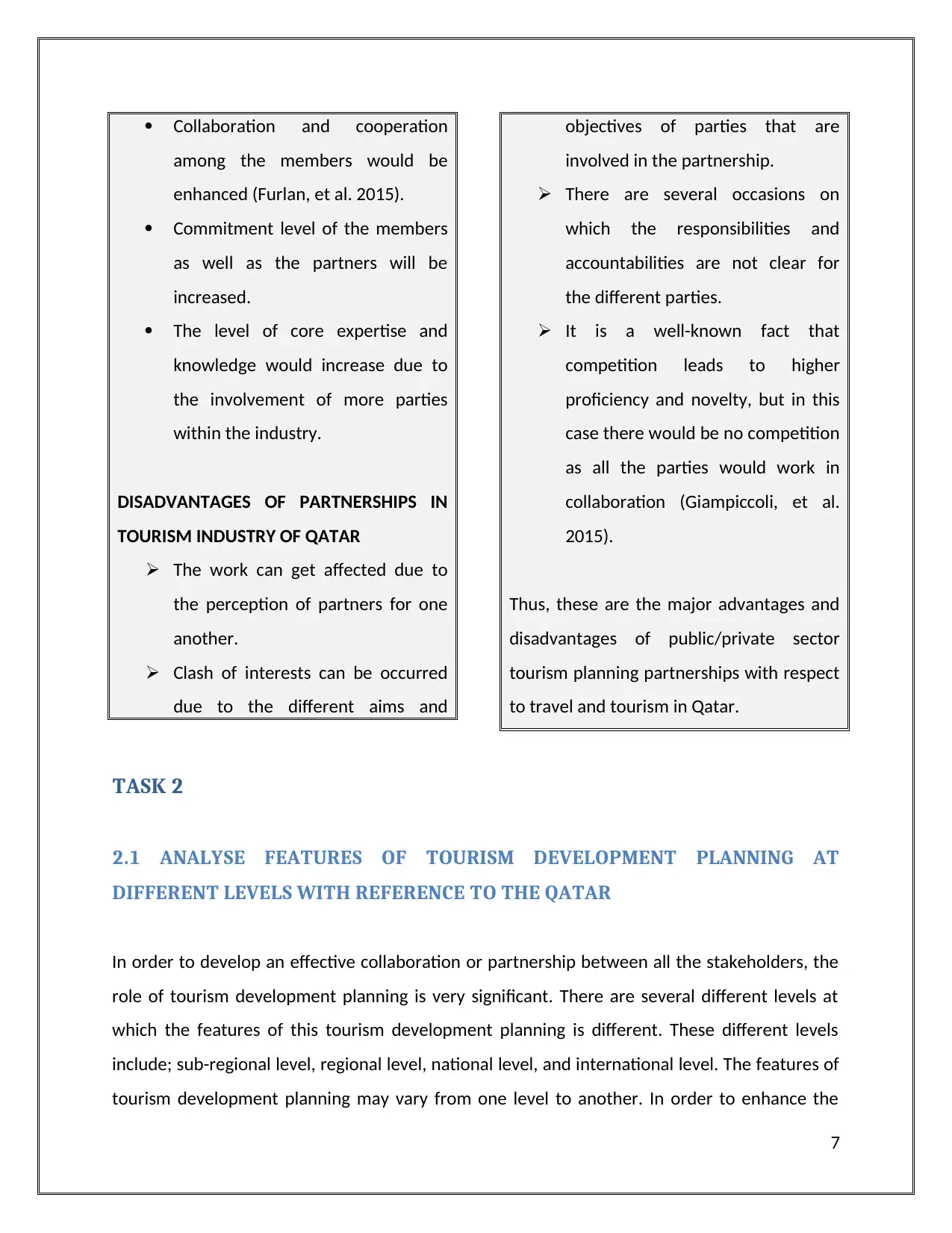
Collaboration and cooperation
among the members would be
enhanced (Furlan, et al. 2015).
Commitment level of the members
as well as the partners will be
increased.
The level of core expertise and
knowledge would increase due to
the involvement of more parties
within the industry.
DISADVANTAGES OF PARTNERSHIPS IN
TOURISM INDUSTRY OF QATAR
The work can get affected due to
the perception of partners for one
another.
Clash of interests can be occurred
due to the different aims and
objectives of parties that are
involved in the partnership.
There are several occasions on
which the responsibilities and
accountabilities are not clear for
the different parties.
It is a well-known fact that
competition leads to higher
proficiency and novelty, but in this
case there would be no competition
as all the parties would work in
collaboration (Giampiccoli, et al.
2015).
Thus, these are the major advantages and
disadvantages of public/private sector
tourism planning partnerships with respect
to travel and tourism in Qatar.
TASK 2
2.1 ANALYSE FEATURES OF TOURISM DEVELOPMENT PLANNING AT
DIFFERENT LEVELS WITH REFERENCE TO THE QATAR
In order to develop an effective collaboration or partnership between all the stakeholders, the
role of tourism development planning is very significant. There are several different levels at
which the features of this tourism development planning is different. These different levels
include; sub-regional level, regional level, national level, and international level. The features of
tourism development planning may vary from one level to another. In order to enhance the
7
among the members would be
enhanced (Furlan, et al. 2015).
Commitment level of the members
as well as the partners will be
increased.
The level of core expertise and
knowledge would increase due to
the involvement of more parties
within the industry.
DISADVANTAGES OF PARTNERSHIPS IN
TOURISM INDUSTRY OF QATAR
The work can get affected due to
the perception of partners for one
another.
Clash of interests can be occurred
due to the different aims and
objectives of parties that are
involved in the partnership.
There are several occasions on
which the responsibilities and
accountabilities are not clear for
the different parties.
It is a well-known fact that
competition leads to higher
proficiency and novelty, but in this
case there would be no competition
as all the parties would work in
collaboration (Giampiccoli, et al.
2015).
Thus, these are the major advantages and
disadvantages of public/private sector
tourism planning partnerships with respect
to travel and tourism in Qatar.
TASK 2
2.1 ANALYSE FEATURES OF TOURISM DEVELOPMENT PLANNING AT
DIFFERENT LEVELS WITH REFERENCE TO THE QATAR
In order to develop an effective collaboration or partnership between all the stakeholders, the
role of tourism development planning is very significant. There are several different levels at
which the features of this tourism development planning is different. These different levels
include; sub-regional level, regional level, national level, and international level. The features of
tourism development planning may vary from one level to another. In order to enhance the
7
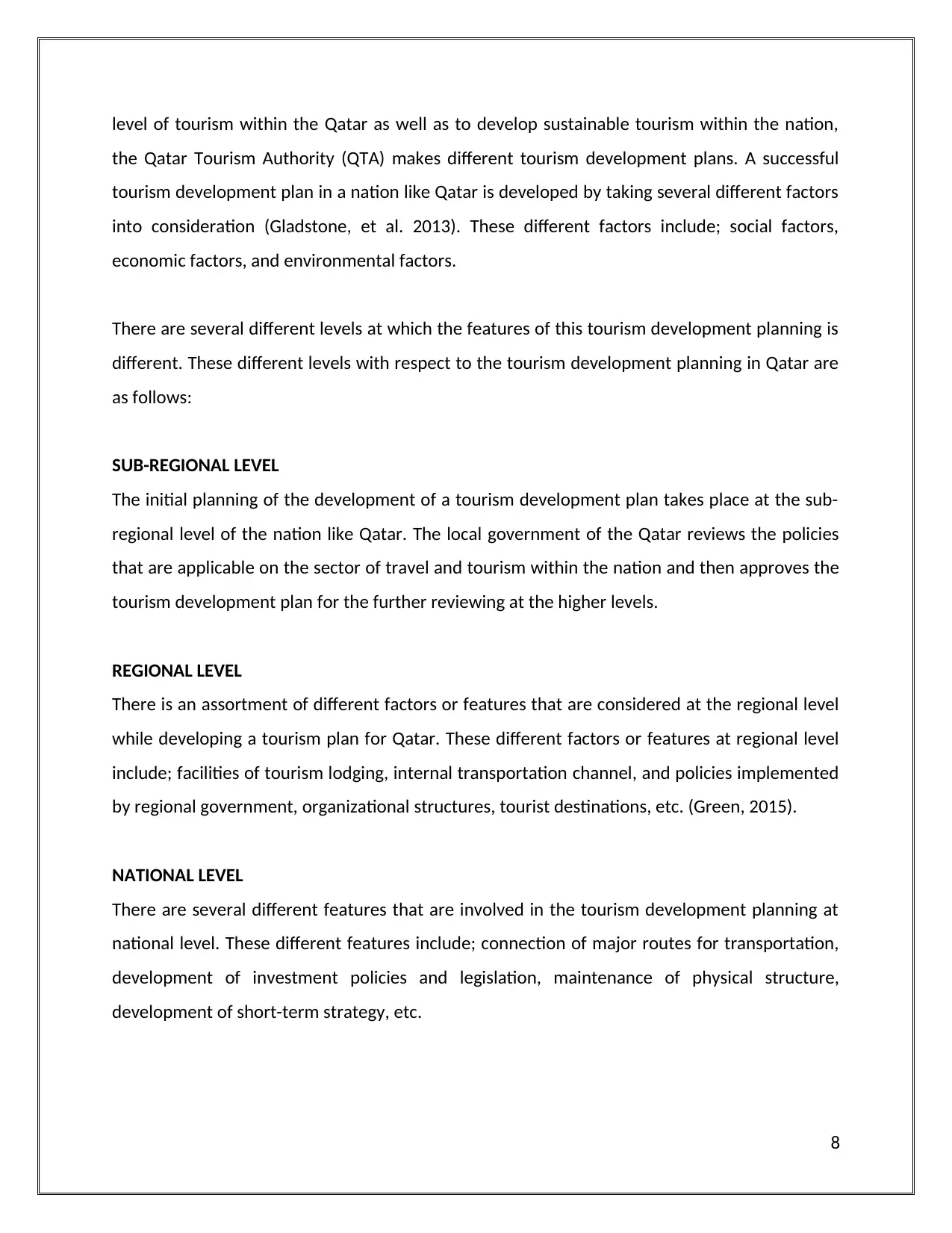
level of tourism within the Qatar as well as to develop sustainable tourism within the nation,
the Qatar Tourism Authority (QTA) makes different tourism development plans. A successful
tourism development plan in a nation like Qatar is developed by taking several different factors
into consideration (Gladstone, et al. 2013). These different factors include; social factors,
economic factors, and environmental factors.
There are several different levels at which the features of this tourism development planning is
different. These different levels with respect to the tourism development planning in Qatar are
as follows:
SUB-REGIONAL LEVEL
The initial planning of the development of a tourism development plan takes place at the sub-
regional level of the nation like Qatar. The local government of the Qatar reviews the policies
that are applicable on the sector of travel and tourism within the nation and then approves the
tourism development plan for the further reviewing at the higher levels.
REGIONAL LEVEL
There is an assortment of different factors or features that are considered at the regional level
while developing a tourism plan for Qatar. These different factors or features at regional level
include; facilities of tourism lodging, internal transportation channel, and policies implemented
by regional government, organizational structures, tourist destinations, etc. (Green, 2015).
NATIONAL LEVEL
There are several different features that are involved in the tourism development planning at
national level. These different features include; connection of major routes for transportation,
development of investment policies and legislation, maintenance of physical structure,
development of short-term strategy, etc.
8
the Qatar Tourism Authority (QTA) makes different tourism development plans. A successful
tourism development plan in a nation like Qatar is developed by taking several different factors
into consideration (Gladstone, et al. 2013). These different factors include; social factors,
economic factors, and environmental factors.
There are several different levels at which the features of this tourism development planning is
different. These different levels with respect to the tourism development planning in Qatar are
as follows:
SUB-REGIONAL LEVEL
The initial planning of the development of a tourism development plan takes place at the sub-
regional level of the nation like Qatar. The local government of the Qatar reviews the policies
that are applicable on the sector of travel and tourism within the nation and then approves the
tourism development plan for the further reviewing at the higher levels.
REGIONAL LEVEL
There is an assortment of different factors or features that are considered at the regional level
while developing a tourism plan for Qatar. These different factors or features at regional level
include; facilities of tourism lodging, internal transportation channel, and policies implemented
by regional government, organizational structures, tourist destinations, etc. (Green, 2015).
NATIONAL LEVEL
There are several different features that are involved in the tourism development planning at
national level. These different features include; connection of major routes for transportation,
development of investment policies and legislation, maintenance of physical structure,
development of short-term strategy, etc.
8
⊘ This is a preview!⊘
Do you want full access?
Subscribe today to unlock all pages.

Trusted by 1+ million students worldwide
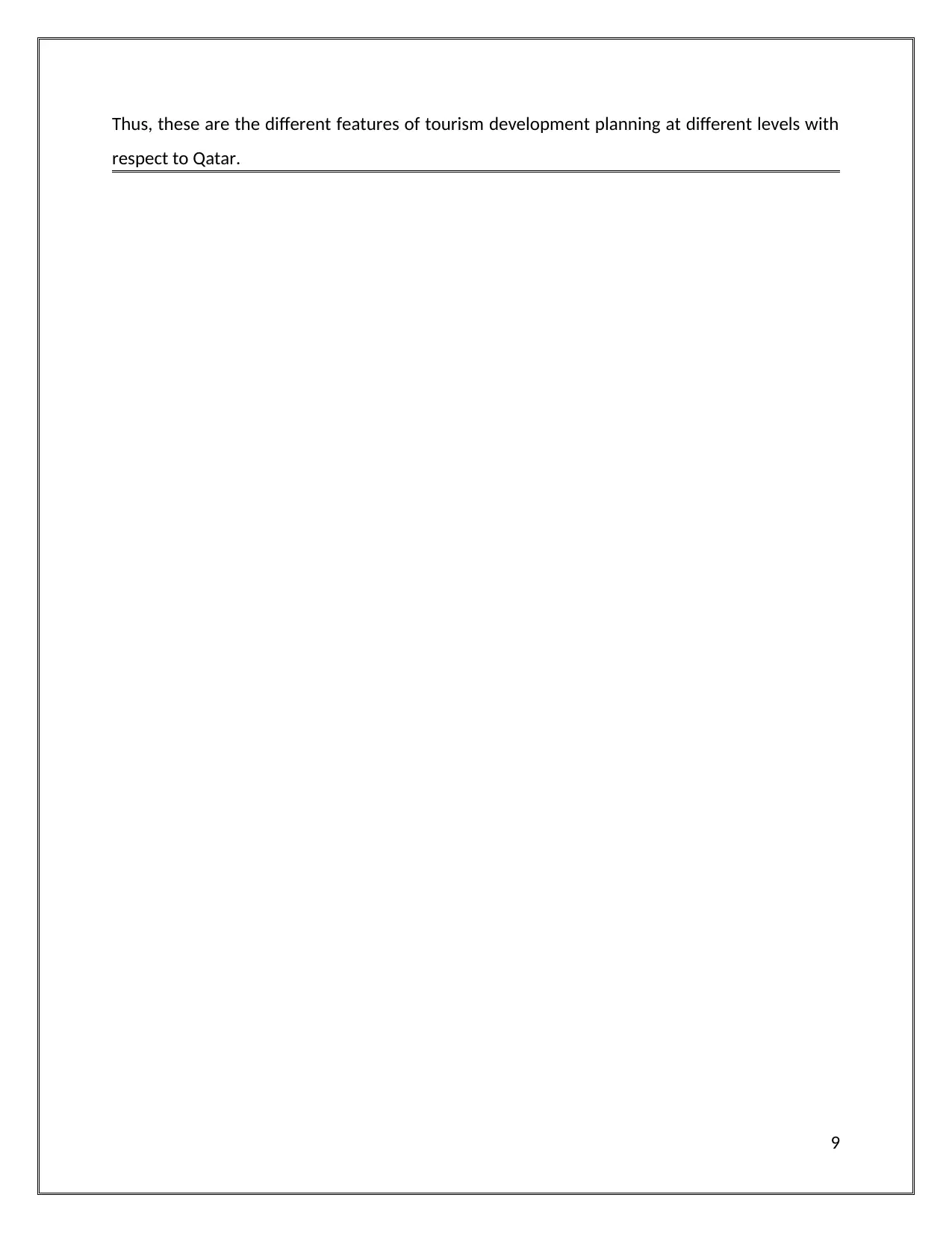
Thus, these are the different features of tourism development planning at different levels with
respect to Qatar.
9
respect to Qatar.
9
Paraphrase This Document
Need a fresh take? Get an instant paraphrase of this document with our AI Paraphraser
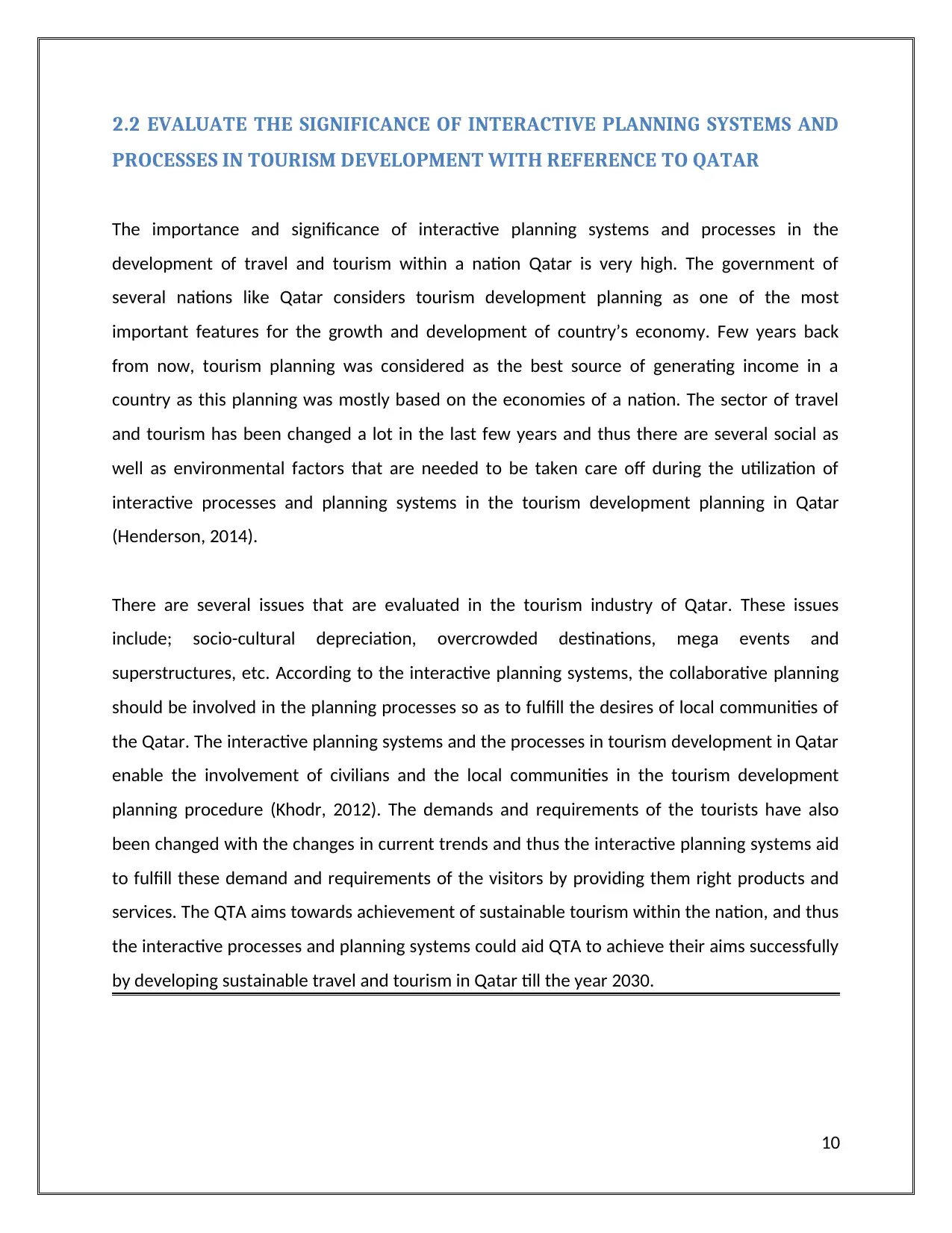
2.2 EVALUATE THE SIGNIFICANCE OF INTERACTIVE PLANNING SYSTEMS AND
PROCESSES IN TOURISM DEVELOPMENT WITH REFERENCE TO QATAR
The importance and significance of interactive planning systems and processes in the
development of travel and tourism within a nation Qatar is very high. The government of
several nations like Qatar considers tourism development planning as one of the most
important features for the growth and development of country’s economy. Few years back
from now, tourism planning was considered as the best source of generating income in a
country as this planning was mostly based on the economies of a nation. The sector of travel
and tourism has been changed a lot in the last few years and thus there are several social as
well as environmental factors that are needed to be taken care off during the utilization of
interactive processes and planning systems in the tourism development planning in Qatar
(Henderson, 2014).
There are several issues that are evaluated in the tourism industry of Qatar. These issues
include; socio-cultural depreciation, overcrowded destinations, mega events and
superstructures, etc. According to the interactive planning systems, the collaborative planning
should be involved in the planning processes so as to fulfill the desires of local communities of
the Qatar. The interactive planning systems and the processes in tourism development in Qatar
enable the involvement of civilians and the local communities in the tourism development
planning procedure (Khodr, 2012). The demands and requirements of the tourists have also
been changed with the changes in current trends and thus the interactive planning systems aid
to fulfill these demand and requirements of the visitors by providing them right products and
services. The QTA aims towards achievement of sustainable tourism within the nation, and thus
the interactive processes and planning systems could aid QTA to achieve their aims successfully
by developing sustainable travel and tourism in Qatar till the year 2030.
10
PROCESSES IN TOURISM DEVELOPMENT WITH REFERENCE TO QATAR
The importance and significance of interactive planning systems and processes in the
development of travel and tourism within a nation Qatar is very high. The government of
several nations like Qatar considers tourism development planning as one of the most
important features for the growth and development of country’s economy. Few years back
from now, tourism planning was considered as the best source of generating income in a
country as this planning was mostly based on the economies of a nation. The sector of travel
and tourism has been changed a lot in the last few years and thus there are several social as
well as environmental factors that are needed to be taken care off during the utilization of
interactive processes and planning systems in the tourism development planning in Qatar
(Henderson, 2014).
There are several issues that are evaluated in the tourism industry of Qatar. These issues
include; socio-cultural depreciation, overcrowded destinations, mega events and
superstructures, etc. According to the interactive planning systems, the collaborative planning
should be involved in the planning processes so as to fulfill the desires of local communities of
the Qatar. The interactive planning systems and the processes in tourism development in Qatar
enable the involvement of civilians and the local communities in the tourism development
planning procedure (Khodr, 2012). The demands and requirements of the tourists have also
been changed with the changes in current trends and thus the interactive planning systems aid
to fulfill these demand and requirements of the visitors by providing them right products and
services. The QTA aims towards achievement of sustainable tourism within the nation, and thus
the interactive processes and planning systems could aid QTA to achieve their aims successfully
by developing sustainable travel and tourism in Qatar till the year 2030.
10
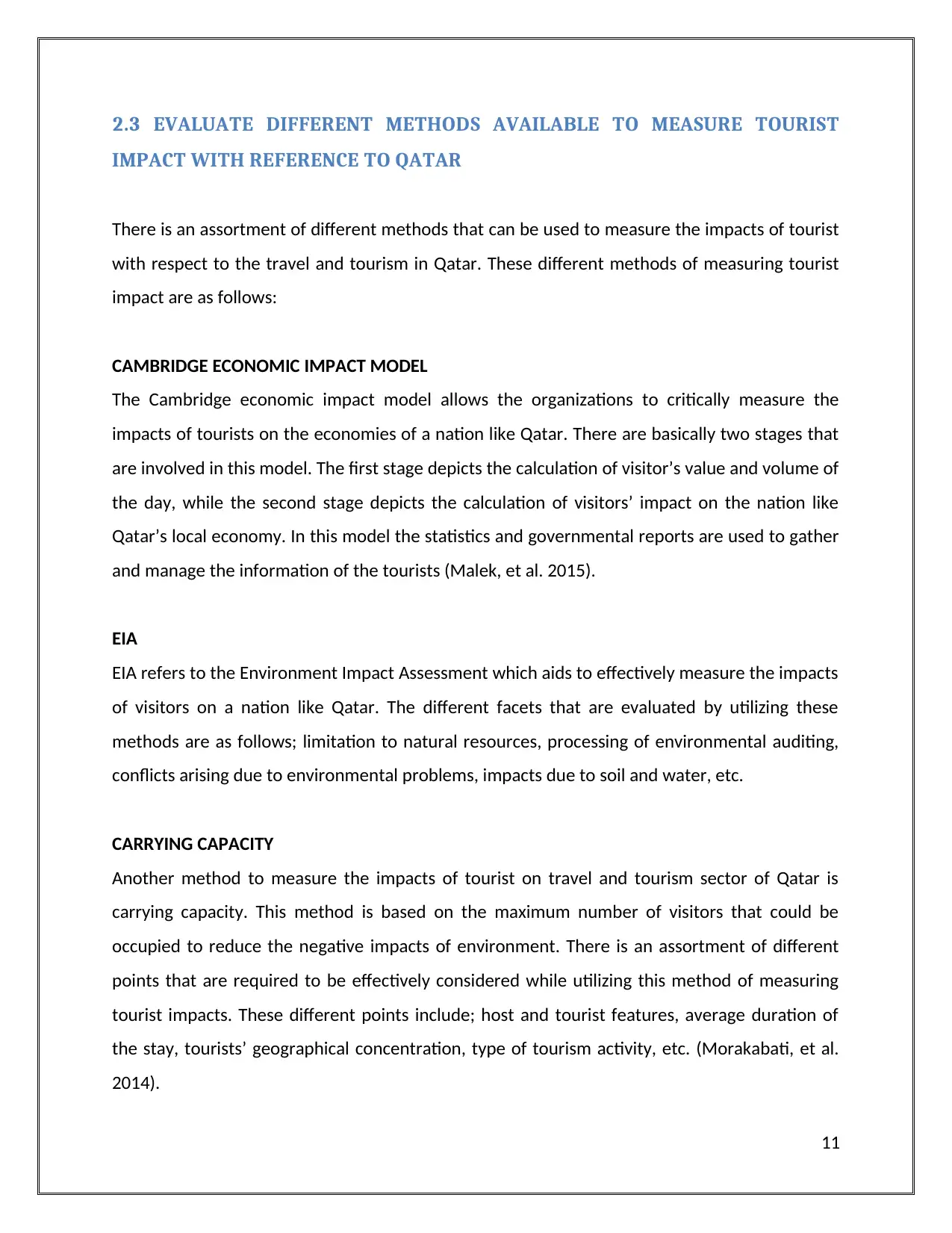
2.3 EVALUATE DIFFERENT METHODS AVAILABLE TO MEASURE TOURIST
IMPACT WITH REFERENCE TO QATAR
There is an assortment of different methods that can be used to measure the impacts of tourist
with respect to the travel and tourism in Qatar. These different methods of measuring tourist
impact are as follows:
CAMBRIDGE ECONOMIC IMPACT MODEL
The Cambridge economic impact model allows the organizations to critically measure the
impacts of tourists on the economies of a nation like Qatar. There are basically two stages that
are involved in this model. The first stage depicts the calculation of visitor’s value and volume of
the day, while the second stage depicts the calculation of visitors’ impact on the nation like
Qatar’s local economy. In this model the statistics and governmental reports are used to gather
and manage the information of the tourists (Malek, et al. 2015).
EIA
EIA refers to the Environment Impact Assessment which aids to effectively measure the impacts
of visitors on a nation like Qatar. The different facets that are evaluated by utilizing these
methods are as follows; limitation to natural resources, processing of environmental auditing,
conflicts arising due to environmental problems, impacts due to soil and water, etc.
CARRYING CAPACITY
Another method to measure the impacts of tourist on travel and tourism sector of Qatar is
carrying capacity. This method is based on the maximum number of visitors that could be
occupied to reduce the negative impacts of environment. There is an assortment of different
points that are required to be effectively considered while utilizing this method of measuring
tourist impacts. These different points include; host and tourist features, average duration of
the stay, tourists’ geographical concentration, type of tourism activity, etc. (Morakabati, et al.
2014).
11
IMPACT WITH REFERENCE TO QATAR
There is an assortment of different methods that can be used to measure the impacts of tourist
with respect to the travel and tourism in Qatar. These different methods of measuring tourist
impact are as follows:
CAMBRIDGE ECONOMIC IMPACT MODEL
The Cambridge economic impact model allows the organizations to critically measure the
impacts of tourists on the economies of a nation like Qatar. There are basically two stages that
are involved in this model. The first stage depicts the calculation of visitor’s value and volume of
the day, while the second stage depicts the calculation of visitors’ impact on the nation like
Qatar’s local economy. In this model the statistics and governmental reports are used to gather
and manage the information of the tourists (Malek, et al. 2015).
EIA
EIA refers to the Environment Impact Assessment which aids to effectively measure the impacts
of visitors on a nation like Qatar. The different facets that are evaluated by utilizing these
methods are as follows; limitation to natural resources, processing of environmental auditing,
conflicts arising due to environmental problems, impacts due to soil and water, etc.
CARRYING CAPACITY
Another method to measure the impacts of tourist on travel and tourism sector of Qatar is
carrying capacity. This method is based on the maximum number of visitors that could be
occupied to reduce the negative impacts of environment. There is an assortment of different
points that are required to be effectively considered while utilizing this method of measuring
tourist impacts. These different points include; host and tourist features, average duration of
the stay, tourists’ geographical concentration, type of tourism activity, etc. (Morakabati, et al.
2014).
11
⊘ This is a preview!⊘
Do you want full access?
Subscribe today to unlock all pages.

Trusted by 1+ million students worldwide
1 out of 37
Related Documents
Your All-in-One AI-Powered Toolkit for Academic Success.
+13062052269
info@desklib.com
Available 24*7 on WhatsApp / Email
![[object Object]](/_next/static/media/star-bottom.7253800d.svg)
Unlock your academic potential
Copyright © 2020–2025 A2Z Services. All Rights Reserved. Developed and managed by ZUCOL.


